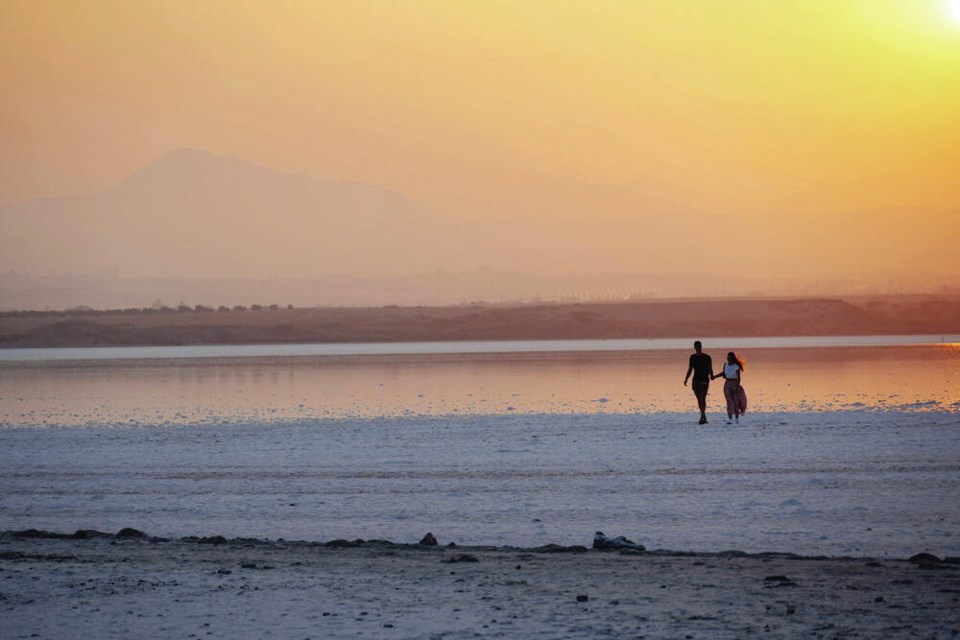Courtesy of the Times Colonist
Photo: A couple walk at the salt lake during sunset in southeast coastal city of Larnaca in southeast Mediterranean island of Cyprus. Health for All stems from a deeply humane concern to ensure everyone in the world enjoys good health, writes Trevor Hancock. AP Photo/Petros Karadjias, File
Way back in 1977, the World Health Organization declared the goal of achieving Health For All by the Year 2000. This should be understood in the way the U.S. Public Health Service defined a goal in 1980: “a timeless statement of aspiration.”
Clearly, Health For All was not achieved, and is still not achieved today. But nonetheless the idea — indeed, the ideal — is important, and it inspired many people, including me.
What is particularly noteworthy is the focus on “all.” In my presentations, I always point out it is not health for a few, not just for some, not even for many, but for all. It stems from a deeply humane concern to include everyone, to ensure everyone in the world enjoys good health.
But the ultimate determinant of the health of everyone in the world is the state of the natural ecosystems of which we are a part, coupled with the extent to which the Earth’s natural resources and biocapacity are fairly distributed within and between societies. Which brings me to Earth For All, a report to the Club of Rome that I mentioned in my Aug. 28 column and is now published.
The report comes 50 years after the Club of Rome released The Limits to Growth, a groundbreaking and controversial exploration of the future of humanity and the Earth.
That 1972 report used a “world systems model” to explore several alternative development scenarios. It found that business as usual led to ecological overshoot and societal collapse in the mid-21st century — now 30 years away. It also found plausible alternative development paths that could avoid collapse — but regrettably, we did not take them then, and are not taking them now.
Earth For All builds on the Limits to Growth, using an updated model to revisit the different scenarios. In addition to business as usual, the report examines two alternatives, one of which assumes twice as much resources are found and used as in the original scenario, while the third assumes a dramatic increase in technology. A fourth scenario was a route to a stabilized world through large-scale societal change.
One of the researchers, Gaya Herrington, looked at how the actual data over the past 40 years for the main elements of the model compared to the trends in the scenarios. She found that “the first three scenarios most accurately tracked the actual data,” which, the authors note, “should set off alarm bells.”
Both business as usual and business as usual with double resources led to societal collapse in the 21st century, the first because “material consumption crashed up against planetary boundaries,” the second because with twice as many resources, “inefficient overuse continued for longer,” resulting in “the biggest collapse due to excessive pollution.”
The “high tech” scenario led to serious declines, but not collapse; only the “stabilized world” scenario led to “widespread increases in human welfare and population stabilization.”
Importantly, in her foreword, Christiana Figueres — a notable global leader on climate change — makes the point that we face a metacrisis that includes “climate chaos, environmental degradation and perverse inequality.” Not only do those crises interact, she writes, they “all share the same deep root: extractivism … [that] not only depletes the planet … it also depletes our human souls.”
The main focus of the book, however — and the accompanying Earth4All website — is not on the problems, but the solutions. The authors note in their opening chapter that “the long-term potential of humanity depends upon civilization … undergoing five extraordinary turnarounds within the coming decades.” And they take an optimistic stance: “Our analysis indicates it’s fully doable” and “can be achieved by 2050.”
The first three of those turnarounds are focused on inequality, underscoring that it is Earth for All, not Earth for a few, some or many: ending poverty, addressing gross inequality and empowering women.
The fourth is to “make our food system healthy for people and ecosystems” and the fifth is to transition to clean energy.
I will address these turnarounds in the coming weeks, linking them to local action in this region. Given their importance, they should be a key focus for the new municipal councils we have just elected.
thancock@uvic.ca
Dr. Trevor Hancock is a retired professor and senior scholar at the University of Victoria’s School of Public Health and Social Policy.
